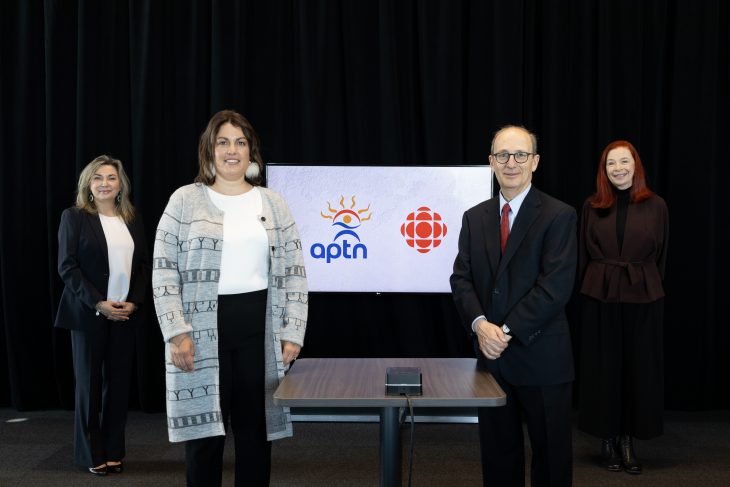
MONTREAL – APTN and CBC/Radio-Canada today announced they have signed a memorandum of understanding (MOU), which formalizes a collaborative partnership between the two organizations that covers entertainment and news programming.
The two organizations, as part of the agreement, will increase opportunities, training and resources for Indigenous creators and expand the audience for Indigenous programming, a press release explains.
They will also collaborate on news and information programming, which means “sharing content and technical resources (such as joint feeds, pooled footage and other resources), while retaining editorial control over their own programming and applying their own journalistic standards and practices,” says the release.
“In addition to programming, both APTN and CBC/Radio-Canada will also collaborate on their common objectives of recruiting, retaining and advancing Indigenous employees and supporting independent Indigenous producers.”
APTN and CBC/Radio-Canada already have a longstanding relationship. “We’ve been working together for decades – CBC/Radio-Canada has been one of APTN’s most consistent partners in commissioning Indigenous stories,” pointed out Monika Ille (above left), CEO of APTN during an interview with Cartt.ca, which included Catherine Tait (right), president and CEO of CBC/Radio-Canada.
However, they wanted to go further and make sure it will continue, Ille said.
The idea for the MOU was sparked when she and Tait first met in January 2020 at an event. Tait said she asked Ille what they could be doing more of and better, together.
“And then she came back to me about it a year later and said, I know what we can do more and better – let’s formalize an agreement, let’s have some guidelines and a framework that will not tell our people what they have to do, but will encourage and start deepening the relationship,” Tait said.
From there, they had their various teams from news, production, programing, and even HR talk to each other. “It was a big crowd of people that really were the authors of this MOU and who talked about all the different ways that we could collaborate and compliment in a more deliberate and thoughtful way,” Tait said.
The MOU is in place for two years to start, but the intention is for it to renew automatically unless something is not going right. “The idea is this is really the, as we say in Hollywood, the beginning of a beautiful thing,” Tait said.
There is the opportunity for the MOU to be updated and possibly extended in the future. Both CEOs have high hopes and big dreams for the partnership and do not anticipate it coming to an end anytime soon.
Ille talked about increasing the number of projects the organizations are collaborating on, and increasing the reach of content they work on and share.
“We’re looking to more collaboration on the news side as well,” she said, explaining there may be stories one broadcaster was able to cover that the other one wants to air on its network, which would increase the reach of the stories.
“And I think you’ll see that overall, it’ll benefit the Canadian public,” Ille said.
Tait talked about wanting the partnership to have an impact. “I think the success is if we can move the needle on Canadians’ appreciation, both non-Indigenous and Indigenous, of the importance of diversity, of diverse perspectives of respect and tolerance,” she said.
“That sounds kind of big, but honestly, we have a lot of work to do in the area of the relationship between Indigenous and non-Indigenous peoples in this country. And so, if we can do anything to… improve that understanding and mutual respect, then I feel that will be success.”
While the MOU is about amplifying Indigenous voices and opportunities for Indigenous creators, a key purpose of it more broadly is centred around reconciliation.
“Both of our organizations were in the Calls to Action of the Truth and Reconciliation Commission,” Tait said.
“Part of our interest in this MOU is to deepen our knowledge. We recognize APTN as the expert in this area, so we see this very much as following their lead, but also, it fits in the broader context of CBC/Radio-Canada’s Indigenous strategy, which we started working on a couple of years ago.”
Tait said all the steps the public broadcaster is taking – with its Indigenous strategy, with committing to improving hiring practices for Indigenous employees, and now with the MOU with APTN – are all steps that are part of a conversation about reconciliation.
“It’s not one thing,” Tait said. “It’s a multi-layered commitment that we made several years ago and that we’ve been amplifying and accelerating because there is nothing more important… for the public broadcaster than to remain relevant to all Canadians, and that includes Indigenous, First Nations, Metis and Inuit peoples as well.”
Ille pointed out the importance of media in reconciliation, and said she believes it is about people coming to understand one another. “Through storytelling, you get to know [people better] – their stories, their history, their culture – and once you get to know people, usually, you start to appreciate them, and that’s at the moment where stereotypes… they start to fall away,” Ille said.
Broadcasters play an important role in sharing these stories, “and when you have the stories coming from Indigenous people with their perspectives and the stories we want to share, that we decide, that we control, it makes a big difference in how we communicate to one another,” Ille said. “Now… we’re not talked about anymore, we’re rather listened to, and that makes a big difference.”
Photo of Ille and Tait with Julie Grenier, chair of APTN’s board of directors (second from the left) and Michael Goldbloom, chair of the CBC/Radio-Canada board of directors (second from the right) during the MOU signing today in Montreal supplied by APTN.



